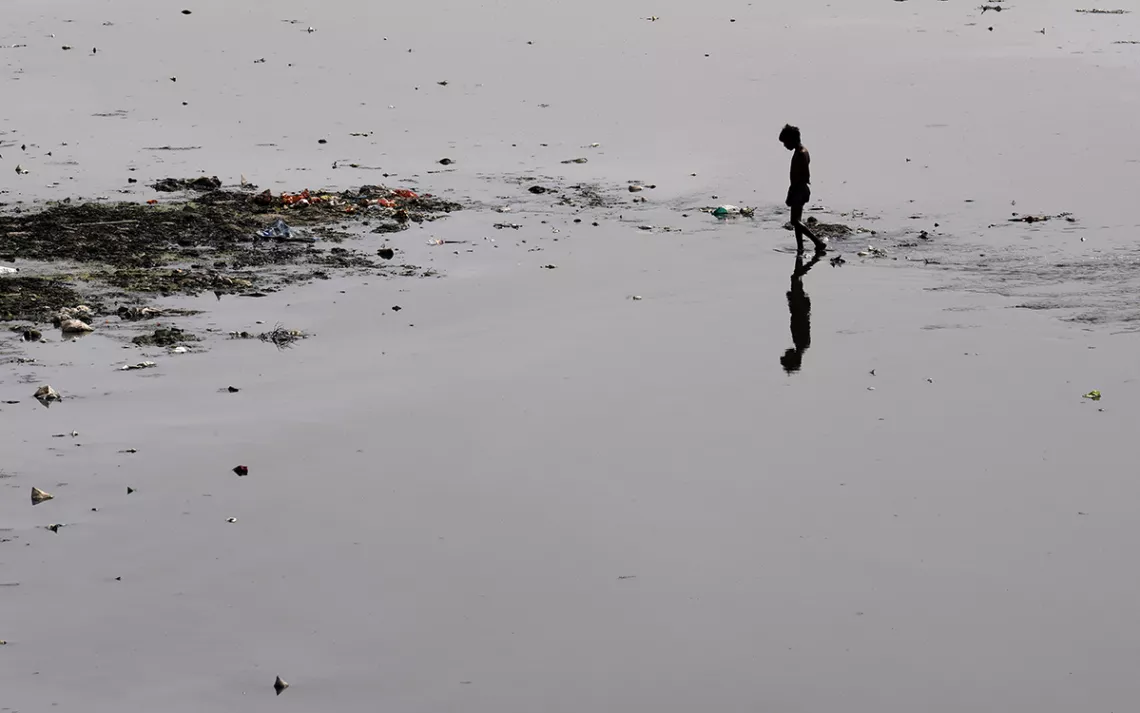Extreme Heat Waves in South Asia Point to Hotter Future
Researchers seek to use data to help protect the most vulnerable

A boy crosses the Yamuna River in New Dehli on May 2, 2022, where water levels have dropped dramatically in the hot weather. | Photo by AP Photo/Manish Swarup
The heat waves have been unrelenting, sparing no one and breaking temperature records so often that it no longer seems like news. Parts of northwestern and central India experienced their hottest April in over 120 years. On May 16, in Uttar Pradesh’s Banda, temperatures reached 120.2°F (49°C). In Pakistan’s Jacobabad, thermometers reached 120.2°F (49°C )—the hottest recorded temperature for the month of April anywhere on Earth.
The impacts, on everything from public health to infrastructure and food production, have been swift and severe. Nearly 30 people succumbed to suspected heatstrokes in India’s western state of Maharashtra. A bridge in Pakistan’s Hunza Valley collapsed after flooding from a glacial lake outburst. Wheat production is down; dehydrated birds are falling from the sky.
Communities here in New Delhi and in regions throughout South Asia are now on the frontlines of a warming world. Today, the planet is 1.2°C hotter than it was before the industrial age—and rising. Heat waves in South Asia are becoming more common and deadlier with time. In 2015, excessive temperatures and an institutional lack of preparedness caused more than 2,500 heat-related deaths. A few weeks later, in a separate event in Pakistan’s largest city of Karachi, 700 fatalities were recorded.
Extreme heat has been linked to everything from hospitalization and premature death to mental illness and even war. The Lancet recently added two new heat-related indicators to its Countdown on health and climate change: the effect of heat on mental well-being and the influence of heat on safe physical activity.
Yet this latest heat wave has even some veteran climate experts expressing surprise.
“Anybody can tell you that it is what we expect in a future climate, with the warming that we’re experiencing,” Krishna AchutaRao, climatologist and head of the Centre for Atmospheric Sciences at the Indian Institute of Technology, Delhi, told Sierra. “But the early time, and also the large area where the heat wave seems to have taken hold—that’s unusual.”
Climate scientists project that each heat wave will be stronger and more severe as a direct consequence of human-induced climate change. In the Indian state of Andhra Pradesh, for example, an attribution study conducted by AchutaRao and colleagues in 2016 found that anthropogenic warming increased the likelihood that the 2015 heat wave would occur by 1,200 percent. AchutaRao is already part of a study on the current heat wave, with results to be published Monday.
Researchers studying these extreme heat events look to tease out more targeted information about how local conditions amplify the effects of global warming. For example, the fertile agrarian tracts of the Indo-Gangetic Plain are the most irrigated landscape in the world, but most climate models don’t take into account irrigation. Some studies say that the likelihood of heat waves in these areas has been reduced by this irrigation, leaving them cooler than they would have been otherwise.
Governments are still trying to sort out how to protect their most vulnerable populations as these heat waves become more common. In 2016, for example, the National Disaster Management Agency of India prepared guidelines for state governments to prevent and manage heat waves with key strategies that include forecasting and enabling an early-warning system; building the capacity of health-care professionals to deal with heat-wave-related emergencies; community outreach; and interagency cooperation.
In 2017, The International Journal of Environmental Research and Public Health released a Heat Vulnerability Index that pinpointed the most vulnerable populations: the very old and the very young, pregnant women, urban slum dwellers, agricultural laborers, and less urbanized people with access to fewer household amenities and water and sanitation. Agricultural workers in countries with low and medium Human Development Index rankings are among the worst affected. In 2020 they bore almost half the 295 billion potential work hours lost due to heat.
“Every city should have a heat action plan with nodal officers appointed for implementation,” Dileep Mavalankar, director of the Indian Institute of Public Health at Gandhinagar and a pioneer of heat action planning in India, told Sierra. “The problem is our health officers are overburdened, and our health systems are understaffed. If an organization is understaffed during any emergency, you will be overwhelmed.” Mavalankar is also part of the Public Health Foundation of India, one of the few organizations trying to bridge the gap between health and weather data. Collecting more nuanced data on temperature, land use changes, mortality, and morbidity, he said, will enable better local vulnerability mapping and adaptation.
Mavalankar said that each at-risk city should have statisticians or data scientists within the health department who are responsible for tracking environmental health hazards like air pollution and heat, and correlate them with daily all-cause mortality to see at what level of air pollution or heat mortality rates rise. “We need to strengthen our health information management system,” he said. “The more granular data we get, the better our predictions and alerting will become, saving more lives.”
“We can’t do this work in the kind of silos we currently have,” AchutaRao said. “Maybe we need a medical cell within the Indian Meteorological Department, or a climate and weather cell in the health ministry.”
Meanwhile, India is still planning to reopen more than 100 coal mines to meet its surging energy demand.
 The Magazine of The Sierra Club
The Magazine of The Sierra Club



